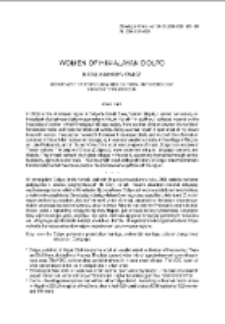- Wyszukaj w całym Repozytorium
- Piśmiennictwo i mapy
- Archeologia
- Baza Młynów
- Nauki przyrodnicze
Wyszukiwanie zaawansowane
Wyszukiwanie zaawansowane
Wyszukiwanie zaawansowane
Wyszukiwanie zaawansowane
Wyszukiwanie zaawansowane

Obiekt
Tytuł: Women of Himalayan Dolpo
Subtitle:
Ethnologia Polona 29-30 (2008-2009)
Publisher:
Institute of Archaeology and Ethnology Polish Academy of Sciences
Place of publishing:
Description:
Type of object:
Abstract:
W himalajskim Dolpo (strefa Karnali, zachodni Nepal) prowadziłam w roku 2008 badania na temat pielgrzymów i szlaków pielgrzymkowych do Góry Kailash. Ponadto zbierałam materiał dotyczący współczesnego życia kobiet w Himalajach. Społeczeństwo Dolpo jest mocno podzielone i świat kobiecy z męskim nie przeplata się. Sama będąc kobietą, większość wolnego czasu spędziłam z kobietami. Z moimi respondentkami poruszałam „kobiece” tematy i wiele informacji zawartych w niniejszym artykule uzyskałam prowadząc swobodne rozmowy, głównie we wsi Ringmo nad jeziorem Phoksundo oraz w Dunai. Dolpo, jeden z najbardziej odległych regionów Nepalu, jest enklawą kultury tybetańskiej. Dolpopów łączy wspólna religia, język, zwyczaje i styl życia. Zamieszkują jedne z najwyżej położonych na świecie wsi, utrzymując się z hodowli zwierząt, rolnictwa i handlu. Etnograficzna i ekologiczna historia Dolpo wykreśla dramatyczną transformację w socjoekonomicznym wzorze regionu
References:
Bauer Kenneth M., 2004, High frontiers: Dolpo and the changing world of Himalayan pastoralists, Colambia University Press, New York
Goldstein Melvyn C., 1971, Stratification, Polyandry, and Family Structure in Central Tibet, Southwestern Journal of Anthropology, 27(1), pp. 64–74
Goldstein Melvyn C., 1987, When Brothers Share a Wife, Natural History, 96(3), pp. 109–112
Gumińska Barbara, Wojewoda Władysław, 1988, Grzyby i ich oznaczanie, PWRiL Warszawa
Jiao Ben, 2001, Socio-economic and Cultural Factors Underlying the Contemporary Revival of Fraternal Polyandry in Tibet. Cleveland
Kind Marietta, 2003, Tapriza Lobtra – A Community Based Culture School and its history, International Conference on Development Assistance to Ethnic Tibetan Communities, Mongolian and Tibetan Affairs Commission Taipei, pp. 24–38
Szynkiewicz Sławoj, 1992, Pokrewieństwo, UW, Warszawa
Valli Eric, Summers Diane, 1988, Dolpo: hidden land of the Himalayas, Aperture, Michigan
Relation:
Volume:
Start page:
End page:
Detailed Resource Type:
Format:
Resource Identifier:
oai:rcin.org.pl:61480 ; 0137-4079
Source:
IAiE PAN, sygn. P 366 ; IAiE PAN, sygn. P 367 ; IAiE PAN, sygn. P 368 ; kliknij tutaj, żeby przejść
Language:
Digitizing institution:
Instytut Archeologii i Etnologii Polskiej Akademii Nauk
Original in:
Biblioteka Instytutu Archeologii i Etnologii PAN
Access:
Kolekcje, do których przypisany jest obiekt:
- Digital Repository of Scientific Institutes > Partners' collections > Institute of Archeology and Ethnology PAS > Institute Publications
- Digital Repository of Scientific Institutes > Partners' collections > Institute of Archeology and Ethnology PAS > Institute Publications > Current Journals
- Digital Repository of Scientific Institutes > Literature > Journals/Articles
- Digital Repository of Scientific Institutes > Partners' collections > Institute of Archeology and Ethnology PAS > Institute Publications > Current Journals > Ethnologia Polona
Data ostatniej modyfikacji:
Feb 2, 2022
Data dodania obiektu:
Jan 10, 2017
Liczba pobrań / odtworzeń:
28
Wszystkie dostępne wersje tego obiektu:
https://rcin.org.pl./publication/76199
Wyświetl opis w formacie RDF:
Wyświetl opis w formacie RDFa:
Wyświetl opis w formacie OAI-PMH:
| Nazwa wydania | Data |
|---|---|
| Maksymowicz, Natalia, 2008-2009, Women of Himalayan Dolpo | Feb 2, 2022 |
Obiekty Podobne
Sykała, Łukasz Dej, Magdalena Wolski, Oskar
Buliński, Tarzycjusz Kairski, Mariusz
Godula-Węcławowicz, Róża
Schild, Romuald (1934– )

 INSTYTUT ARCHEOLOGII I ETNOLOGII POLSKIEJ AKADEMII NAUK
INSTYTUT ARCHEOLOGII I ETNOLOGII POLSKIEJ AKADEMII NAUK
 INSTYTUT BADAŃ LITERACKICH POLSKIEJ AKADEMII NAUK
INSTYTUT BADAŃ LITERACKICH POLSKIEJ AKADEMII NAUK
 INSTYTUT BADAWCZY LEŚNICTWA
INSTYTUT BADAWCZY LEŚNICTWA
 INSTYTUT BIOLOGII DOŚWIADCZALNEJ IM. MARCELEGO NENCKIEGO POLSKIEJ AKADEMII NAUK
INSTYTUT BIOLOGII DOŚWIADCZALNEJ IM. MARCELEGO NENCKIEGO POLSKIEJ AKADEMII NAUK
 INSTYTUT BIOLOGII SSAKÓW POLSKIEJ AKADEMII NAUK
INSTYTUT BIOLOGII SSAKÓW POLSKIEJ AKADEMII NAUK
 INSTYTUT CHEMII FIZYCZNEJ PAN
INSTYTUT CHEMII FIZYCZNEJ PAN
 INSTYTUT CHEMII ORGANICZNEJ PAN
INSTYTUT CHEMII ORGANICZNEJ PAN
 INSTYTUT FILOZOFII I SOCJOLOGII PAN
INSTYTUT FILOZOFII I SOCJOLOGII PAN
 INSTYTUT GEOGRAFII I PRZESTRZENNEGO ZAGOSPODAROWANIA PAN
INSTYTUT GEOGRAFII I PRZESTRZENNEGO ZAGOSPODAROWANIA PAN
 INSTYTUT HISTORII im. TADEUSZA MANTEUFFLA POLSKIEJ AKADEMII NAUK
INSTYTUT HISTORII im. TADEUSZA MANTEUFFLA POLSKIEJ AKADEMII NAUK
 INSTYTUT JĘZYKA POLSKIEGO POLSKIEJ AKADEMII NAUK
INSTYTUT JĘZYKA POLSKIEGO POLSKIEJ AKADEMII NAUK
 INSTYTUT MATEMATYCZNY PAN
INSTYTUT MATEMATYCZNY PAN
 INSTYTUT MEDYCYNY DOŚWIADCZALNEJ I KLINICZNEJ IM.MIROSŁAWA MOSSAKOWSKIEGO POLSKIEJ AKADEMII NAUK
INSTYTUT MEDYCYNY DOŚWIADCZALNEJ I KLINICZNEJ IM.MIROSŁAWA MOSSAKOWSKIEGO POLSKIEJ AKADEMII NAUK
 INSTYTUT PODSTAWOWYCH PROBLEMÓW TECHNIKI PAN
INSTYTUT PODSTAWOWYCH PROBLEMÓW TECHNIKI PAN
 INSTYTUT SLAWISTYKI PAN
INSTYTUT SLAWISTYKI PAN
 SIEĆ BADAWCZA ŁUKASIEWICZ - INSTYTUT TECHNOLOGII MATERIAŁÓW ELEKTRONICZNYCH
SIEĆ BADAWCZA ŁUKASIEWICZ - INSTYTUT TECHNOLOGII MATERIAŁÓW ELEKTRONICZNYCH
 MUZEUM I INSTYTUT ZOOLOGII POLSKIEJ AKADEMII NAUK
MUZEUM I INSTYTUT ZOOLOGII POLSKIEJ AKADEMII NAUK
 INSTYTUT BADAŃ SYSTEMOWYCH PAN
INSTYTUT BADAŃ SYSTEMOWYCH PAN
 INSTYTUT BOTANIKI IM. WŁADYSŁAWA SZAFERA POLSKIEJ AKADEMII NAUK
INSTYTUT BOTANIKI IM. WŁADYSŁAWA SZAFERA POLSKIEJ AKADEMII NAUK




































